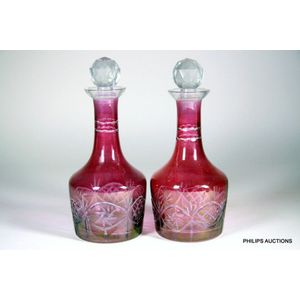Cranberry Glass Decanters with Etched Vines and Grapes
You must be a subscriber, and be logged in to view price and dealer details.
Subscribe Now to view actual auction price for this item
When you subscribe, you have the option of setting the currency in which to display prices to $Au, $US, $NZ or Stg.
- Pontil Mark - A pontil mark, also known as a pontil scar, is a distinctive mark or scar found on the base of certain types of glass. It is a remnant of the glassblowing process and is particularly associated with handcrafted items made prior to the widespread use of automated manufacturing.
The pontil mark is created during the final stages of production. After the glassblower has shaped and formed the glass object, it is removed from the blowing iron. At this point, the glass object is often attached to a solid rod called a pontil rod or punty for further shaping, finishing, or attaching additional components. The attachment point is typically at the base of the object.
Once the glass item is complete, it is detached from the pontil rod, leaving behind a mark or scar on the base. This mark can take various forms, such as a rough or irregular surface, a concave or slightly recessed area, or a small circular scar. The presence of a pontil mark indicates that the item was handcrafted rather than mass-produced.
Collectors and historians often use pontil marks as clues to determine the age, authenticity, and production methods of glass or ceramic pieces. Different types of pontil marks may suggest different techniques used in the production process. For example, an open pontil mark is one where the scar is left as an exposed, roughened area, while a closed pontil mark occurs when the scar is smoothed or covered in some way. It's important to note that not all handcrafted glass items have pontil marks, as some artisans developed alternative methods for finishing their work. In Edwardian times the pontil mark was oftern ground off leaving a concave circle in the centre of the base of the object.
The use of pontil marks diminished with the advent of industrialization and automated manufacturing processes in the 19th and 20th centuries. - Oviform /ovoid - The outline loosely resembling the shape of an egg.
This item has been included into following indexes:
Visually similar items

A pair of antique cranberry flash glass decanters, 19th century, the mallet shaped decanters with clear facet cut globe stoppers, each with borders of star, diamond and pineapple cuts and concentric borders to the neck, height 20.5 cm

Pair Cantonese export bottle vase & covers famille rose painted, court scenes within scattered floral & emblem ground, 39 cm height (faults)

A Chinese painted-enamel vase, Attributed to Wang Qi, painted around the body with figures of an old gentleman and his servant resting in an autumn forest, inscribed with a poem appropriating the scene, signed, 'Year of kuiyou (1933), Wang Qi, Zhu Shan', a

Green and red 'Dog of Foo' Chinese vase in the baluster shape, with extended rim and the guardian lion among a field of flowers, the neck graced with a phoenix in between two symmetrical patterns, height 45 cm
